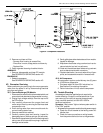
9
CD-7 thru CD-15 Infinity Corona Discharge Ozone Generator
HEALTH HAZARDS OF OZONE
Detection Levels
Ozone can be detected in air by its distinctive odor at
concentrations of about 0.02 ppm. Although each nose
varies, olfactory fatigue occurs quickly. As a result, DO
NOT RELY ON ODOR AS A WARNING OF HIGH
OZONE CONCENTRATIONS.
The permissible exposure level (PEL) or time weighted
concentration for ozone to which workers may be
exposed os 0.1 ppm averaged over 8 hours, 5 days a
week (OSHA). The short term exposure limit is 0.3 ppm
average over 15 minutes. The concentration of 10 ppm
ozone in air is generally accepted as immediately
Dangerous to Life or Health (DLH).
Effects on Humans
Ozone acts as a primary irritant, affecting mainly the
eyes, upper respiratory tract and the lungs. Onset of
pulmonary edema (fluid buildup in the lungs) may be
delayed for a few hours after exposure. Inhaling ozone
at concentrations of 50 ppm for 30 minutes can be fatal.
Many people exposed to airborne ozone rapidly develop
a headache, which often disappears after a few minutes
in fresh air.
Reduction in lung function due to scar tissue forming in
the lung may occur due to long-term exposure to ozone
at concentrations above 0.2 ppm, or a single high
exposure. Although medical studies show no evidence
of ozone causing cancer or lung allergies or harming the
unborn, there is some evidence that the oxidizing power
of ozone could lead to premature aging of the body as a
whole.
The owner of any ozone installation should advise any
person who may be exposed to ozone that those with a
history of heart or respiratory disease should take every
precaution to avoid exposure to ozone.
FIRST AID
General
First Action
1. If exposure to ozone causes headache or shortness
of breath, immediately remove the patient to a fresh
air environment.
Second Action
1. Workers who have been exposed to low concentra-
tions of ozone should be given oxygen to breathe
while under the observation of trained personnel.
2. If exposure is sever, send for medical assistance
immediately.
Inhalation
First Action
1. Assess patient's breathing.
2. All unconscious patients must be placed in the
drainage position (on their sides), so that fluids can
drain from the airways once breathing has been
restored.
3. Check pulse.
Second Action
1. If breathing has ceased, start artificial respiration
(rescue breathing is the most effective) method until
breathing has been restored.
2. Send for medical assistance immediately.
3. If absent, begin cardiopulmonary resuscitation
(CPR).
Eye Contact
First Action
1. Effective irrigation should start immediately. Eyes
should be irrigated for 30 minutes by the clock with
running tap water or preferably normal saline.
Second Action
1. Effective irrigation must be continued while en route
to hospital.
Precautions
Workers with a previous cardiopulmonary (heart and
lung) condition must consult their physician prior to
working in an area in which they may be exposed to
ozone. Significant alterations in cardiopulmonary
functions have been documented when such workers
have been exposed to low concentration of ozone.
END OF DOCUMENT.













